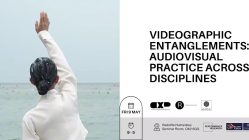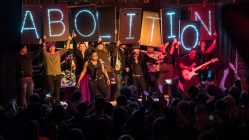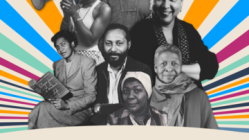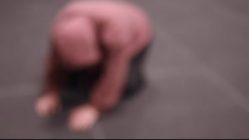Duration: 3:48
Project: Judaica
Song: Shishelai
Practitioner: Nazlıhan Eda Erçin
Director: Ben Spatz
Videography: Agnieszka Mendel
Date: 9 May 2017
Venue: Centre for Psychophysical Performance Research
Source File: J010-E
COMMENTARY
Eda
The first song I chose to start the work, ‘Shishelai’ / Şişeler has opened a wide and unplanned territory of exploration for me within the songwork based on the question: What is identity in the laboratory?
This is one of the many sessions where I am directed by Ben, and producing distinct song-actions based on ‘Shishelai’ / Şişeler, such as verbal conversation, body rhythm, belly dancing, and body shaking. The only thing I am not doing is standing and only singing the song as a whole. The song arrives me as independent words, phrases, and exclamations as it has a conversational tone with no unifying narrative. The lyrics do not follow a logical order but rather propose a story with gaps in between which would be filled in many possible ways producing many different stories and characters. I am patiently following chosen parts of the song and repeating it for numerous times until an action emerges, something that I can hold on to.
The video portrays a specific and astonishing moment which leads me into the song-action of verbal conversation. I hear myself repeating the phrases of hacı cavcav and oh, canıma değsin without thinking what they mean in the context of this song. I repeat them and observe what they are doing to me, how they are changing my voice, intonation, attitude, gestures and way of speaking. At 2:04, the words are growing in my mouth like a huge piece of chewing gum that I can neither control nor get rid of, all I can do is to continue what I am doing and making sure that I can still breathe. The verbal phrases lead the action in a way that the song does not seem to be in the space with me anymore in its known and recognisable form (it is somewhat ‘distorted’). It leaves me some merging characters which sound like (but not an exact re-enactment of) various Anatolian oral folk storyteller character such as meddah and the well-known shadow puppet character Karagöz. Through a grotesque flow of speech (00:01), gesture (1:30), movement repetition (03:10) and gibberish (02:14), I am re-finding the song at unexpected moments (2:31, 3:40). As it is a form in which I find joy as a practitioner, I am looking forward to further exploration of the grotesque in the songwork.
Ben
When I started offering some direction to Eda at the beginning of this process, I began by proposing to work with ‘song-actions’ as I have been doing since 2015. Song-actions are adapted from Massimiliano Balduzzi’s approach to ‘exercise-actions‘. They are repeatable actions that combine elements of vocal and physical precision with specific associations and intentions. Each song-action is based on a song fragment, a piece or version of a song which is then developed in a particular direction. In our early sessions, I guided Eda to develop four song-actions out of ‘Shishelai’. At the time I did not know anything about the song as was not concerned with its history or verbal meaning. I trusted Eda’s care and connection to the song to be generative and meaningful. My focus was on the development of four very distinct song-actions which could help open up the territory of this song and of songwork in general.
During our first focused trio conversation, Eda referred to what we were doing as ‘distortion’ of the song. This was jarring for me because I think of song fragments and song-actions as unfolding a song, discovering hidden potentials inside it which later can be refolded back into the song, producing a kind of density. This issue is very profound. I know from my reading of social epistemology that it is not just a phenomenon of the ’embodied’ laboratory but appears also in the hard sciences. The question is whether research discovers or produces its objects. Positivist scientists claim that they merely discover what is already ‘out there’ while a strong social constructionism claims that science constructs and generates new social phenomena. New theories of materialism, including my own theory of technique, integrate these perspectives by recognizing that knowledge is both social and material.
What I know is that songs do guide songwork. One does not simply do whatever one wishes with a song. Melodies, rhythms, phonemes, and other musical structures, as well as many kinds of associations, all influence what kinds of ‘actions’ one develops. The song pushes back in some way against the will of the practitioner; it makes itself known. Song and individual meet in practice. This negotiation is research. It involves creativity but is not purely inventive. A song is not an open field. It is a territory with particular channels and pathways, valleys and mountains, potentials and resistances. Does a microscope distort a molecule? Does a historian distort the past? We like to think that we are merely serving or unfolding our objects of research, but of course we also distort and construct them at every step along the way.






